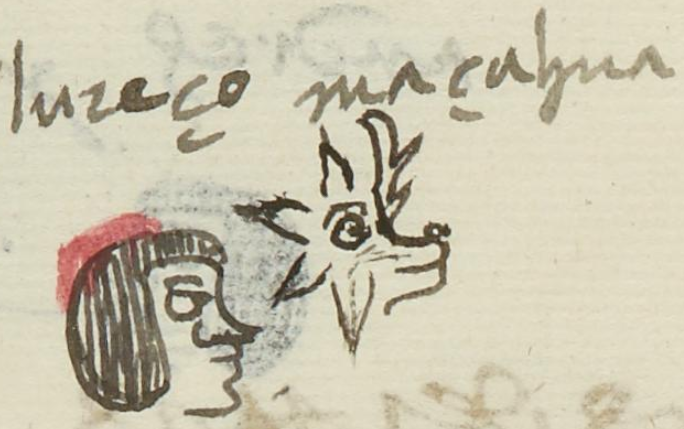Mazahua (MH651r)
This black-line drawing of the simplex glyph of the personal name (or ethnicity) Mazahuatl, has the (European) shape of a sun or star coming out of the left side of the head of a deer (mazatl). The deer is shown in profile, looking toward the viewer’s right.
Stephanie Wood
Juan José Batalla Rosado (2018, 89–90) has suggested that a similar representation of the ethnicity called Mazahua, which looks like a full sun or star, is a phonetic reproduction of deer (mazatl) spines (ahuatl), without intending the corresponding meaning. Early on, the word for deer was applied to horses, which were a re-introduction from Europe. And the spiky partial shape here, as suggested by Batalla, points to the spur that horseback riders would wear on their boots. This same shape is echoed in a number of other glyphs in the Matrícula de Huexotzinco, as Batalla demonstrates. I have also seen a similar shape used for the name Citlal, but that one is greatly removed from all the others, which represent the neologism tepozahuatl (metal spines) or tepozhuitztli (metal thorns).
Stephanie Wood
1560
Jeff Haskett-Wood
venados, estrellas, soles, nombres de hombres

Mazahua, a culture group to the west of central Mexico, https://nahuatl.wired-humanities.org/content/mazahua
Mazahuatl, a name or person of the Mazahua ethnic group, https://nahuatl.wired-humanities.org/content/mazahuatl
maza(tl), deer, https://nahuatl.wired-humanities.org/content/mazatl
(una persona Mazahua)
Stephanie Wood
Matrícula de Huexotzinco, folio 651r, World Digital Library, https://www.loc.gov/resource/gdcwdl.wdl_15282/?sp=384&st=image
This manuscript is hosted by the Library of Congress and the World Digital Library; used here with the Creative Commons, “Attribution-NonCommercial-ShareAlike 3.0 License” (CC-BY-NC-SAq 3.0).





